Experimental and Numerical Studies on the Impact Energy Absorption of Cutting Shear Rings
Abstract
:1. Introduction
2. Design of Energy Absorption Device
3. Drop Hammer Test
3.1. The Method of Test
3.2. The Test Results
4. Numerical Simulation
4.1. Finite Element Modeling and Material Parameters
4.2. Comparison of Simulation Results
5. Discussion
5.1. Influence of Shear Ring Thickness
5.2. Influence of Shear Ring Spacing
- Impact energy absorption characteristics of shear rings: By analyzing and comparing the impact energy absorption characteristics of shear rings under nine working conditions, it can be seen that increasing the thickness of shear rings is obviously better than reducing the spacing of shear rings to improve the energy absorption of the device. Because with the reduction of the spacing of shear rings, the energy absorption of the device increases linearly, and with the increase in shear ring thickness, the upward trend of energy absorption of the device is more obvious. Moreover, reducing the spacing of shear rings not only increases the processing procedure but also the quality of the energy absorption rods is greater than that of increasing the thickness, which is not conducive to the lightweight of the energy absorption device.
- Characteristics of the peak force in the energy absorption process of shear rings impact: The failure of each shear ring in the energy absorption process is accompanied by the generation of peak force, but the maximum peak force usually occurs when the first shear ring is destroyed. There is a linear trend between the shear ring thickness and the peak force, but the spacing of the shear rings has little effect on the peak force. Therefore, in the application process of the energy absorption device, the thickness of the shear ring should be determined according to the installation conditions to ensure that the device will not fall off in the process of energy absorption. Then, according to the requirements for energy absorption, the appropriate spacing of shear rings is selected to achieve the purposes of collision mitigation and energy absorption.
6. Conclusions
- Through the analysis of the F–T curve obtained from the drop hammer impact test, it is found that the energy absorption process of shear rings is often accompanied by the generation of peak forces, which plays an important role in determining whether the installation of the device is secure and whether the energy absorption process can be carried out effectively.
- By comparing the experiment with numerical simulation, the accuracy and rationality of the comprehensive modeling method of an energy absorption device based on CSR are verified. The preliminary study using numerical simulation can save a lot of human and material resources and greatly improve the research’s efficiency.
- There is an obvious positive correlation between the energy absorption of the device and the number and thickness of shear rings. To be exact, there is a linear trend between the number of shear rings and the energy absorption, and the slope increases with the increase in thickness.
- The peak force of the shear rings’ impact energy absorption process is positively correlated with the thickness of the shear rings. It occurs when each shear ring fails, and the maximum peak force usually occurs when the first shear ring fails.
Author Contributions
Funding
Institutional Review Board Statement
Informed Consent Statement
Data Availability Statement
Conflicts of Interest
References
- Scholes, A. Development of Collision Technologies in European Railways. Foreign Roll. Stock. 1998, 1, 23–26. [Google Scholar]
- Cheng, L. The Study of Passive-Safety System and Modular Design for Railway Vehicle. Master’s Thesis, Tongji University, Shanghai, China, 2006. [Google Scholar]
- Yan, J.; Yao, S.; Xu, P.; Peng, Y.; Shao, H.; Zhao, S. Theoretical prediction and numerical studies of expanding circular tubes as energy absorbers. Int. J. Mech. Sci. 2016, 105, 206–214. [Google Scholar] [CrossRef]
- Xilu, Z.; Kong, C.; Yang, Y.; Hagiwara, I. Reversed-Torsion-Type Crush Energy Absorption Structure and Its Inexpensive Partial-Heating Torsion Manufacturing Method Based on Origami Engineering. J. Manuf. Sci. Eng. 2022, 144, 061001. [Google Scholar] [CrossRef]
- Li, B.; Lu, Z.; Yan, K.; Lu, S.; Kong, L.; Xu, P. Experimental study of a honeycomb energy-absorbing device for high-speed trains. Proc. Inst. Mech. Eng. Part F J. Rail Rapid Transit 2020, 234, 1170–1183. [Google Scholar] [CrossRef]
- Ma, J.; Chai, S.; Chen, Y. Geometric design, deformation mode, and energy absorption of patterned thin-walled structures. Mech. Mater. 2022, 168, 104269. [Google Scholar] [CrossRef]
- San, H.N.; Lu, G. Thin-walled corrugated structures: A review of crashworthiness designs and energy absorption characteristics. Thin-Walled Struct. 2020, 157, 106995. [Google Scholar]
- Duan, Y.; Zhang, T.; Zhou, J.; Xiao, H.; Chen, X.; Al Teneiji, M.; Guan, Z.W.; Cantwell, W.J. Energy-absorbing characteristics of hollow-cylindrical hierarchical honeycomb composite tubes inspired a beetle forewing. Compos. Struct. 2021, 278, 114637. [Google Scholar] [CrossRef]
- Zhai, J.; Zhang, D.; Li, M.; Cui, C.; Cai, J. Out-of-plane energy absorption and crush behavior of origami honeycomb. Thin-Walled Struct. 2022, 181, 109966. [Google Scholar] [CrossRef]
- Baroutaji, A.; Sajjia, M.; Olabi, A.G. On the crashworthiness performance of thin-walled energy absorbers: Recent advances and future developments. Thin-Walled Struct. 2017, 118, 137–163. [Google Scholar] [CrossRef] [Green Version]
- Li, Z. Study on Energy Absorption Characteristics and Crashworthiness Optimization of Thin-Walled Structures. Ph.D. Thesis, South China University of Technology, Guangzhou, China, 2019. [Google Scholar]
- Reddy, S.; Abbasi, M.; Fard, M. Multi-cornered thin-walled sheet metal members for enhanced crashworthiness and occupant protection. Thin-Walled Struct. 2015, 94, 56–66. [Google Scholar] [CrossRef]
- Li, G.; Zhang, Z.; Sun, G.; Huang, X.; Li, Q. Comparison of functionally-graded structures under multiple loading angles. Thin-Walled Struct. 2015, 94, 334–347. [Google Scholar] [CrossRef]
- Sun, G.; Huo, X.; Wang, H.; Hazell, P.J.; Li, Q. On the structural parameters of honeycomb-core sandwich panels against low-velocity impact. Compos. Part B Eng. 2021, 216, 108881. [Google Scholar] [CrossRef]
- Mousanezhad, D.; Ghosh, R.; Ajdari, A.; Hamouda, A.M.S.; Nayeb-Hashemi, H.; Vaziri, A. Impact resistance and energy absorption of regular and functionally graded hexagonal honeycombs with cell wall material strain hardening. Int. J. Mech. Sci. 2014, 89, 413–422. [Google Scholar] [CrossRef]
- Yao, S.J.; Zhang, D.; Lu, F.Y.; Li, X.C. Experimental and numerical studies on the failure modes of steel cabin structure subjected to internal blast loading. Int. J. Impact Eng. 2017, 110, 279–287. [Google Scholar] [CrossRef]
- Yao, S.J.; Zhang, D.; Lu, Z.J.; Lin, Y.L.; Lu, F.Y. Experimental and numerical investigation on the dynamic response of steel chamber under internal blast. Eng. Struct. 2018, 168, 877–888. [Google Scholar] [CrossRef]
- Zhao, N.; Yao, S.J.; Zhang, D.; Lu, F.Y.; Sun, C.M. Experimental and numerical studies on the dynamic response of stiffened plates under confined blast loads. Thin-Walled Struct. 2020, 154, 106839. [Google Scholar] [CrossRef]
- Song, J.; Chen, Y.; Lu, G. Axial crushing of thin-walled structures with origami patterns. Thin-Walled Struct. 2012, 54, 65–71. [Google Scholar] [CrossRef]
- Wang, Y.; Xiao, L.; Jiang, C.; Jia, Y.; Yang, G.; Li, M.; Tang, X.; Chen, D. Axial Loading Behaviour of Self-Compacting Concrete-Filled Thin-Walled Steel Tubular Stub Columns. Adv. Civ. Eng. 2021, 2021, 8861340. [Google Scholar] [CrossRef]
- Liu, S.; Liu, Y.; Zhang, Y.; Li, Z. Low speed impact response of carbon fiber-aluminum foam sandwich panels. Chin. J. High Press. Phys. 2020, 34, 107–116. [Google Scholar]
- Yu, P.; Liu, Z.; Li, S. Design and energy absorption characteristic analysis of a new bamboo thin-walled circular tube. Chin. J. High Press. Phys. 2021, 35, 104–114. [Google Scholar]
- Li, P.; Yang, F.; Bian, Y.; Zhang, S.; Wang, L. Deformation pattern classification and energy absorption optimization of the eccentric body centered cubic lattice structures. Int. J. Mech. Sci. 2021, 212, 106813. [Google Scholar] [CrossRef]
- Zhao, M.; Zhang, D.; Liu, F.; Li, Z.; Ma, Z.; Ren, Z. Mechanical and energy absorption characteristics of additively manufactured functionally graded sheet lattice structures with minimal surfaces. Int. J. Mech. Sci. 2020, 167, 105262. [Google Scholar] [CrossRef]
- Beik, V.; Fard, M.; Jazar, R. Crashworthiness of tapered thin-walled S-shaped structures. Thin-Walled Struct. 2016, 102, 139–147. [Google Scholar] [CrossRef]
- Jung, A.; Lach, E.; Diebels, S. New hybrid foam materials for impact protection. Int. J. Impact Eng. 2014, 64, 30–38. [Google Scholar] [CrossRef]
- Chang, N. Simulation of Energy-Absorbing Process in Metal-Cutting Way. Master’s Thesis, Central South University, Shanghai, China, 2006. [Google Scholar]
- Chang, N.; Liu, G. Simulation for energy-absorbing process of railway vehicle in metal-cutting way. J. Cent. South Univ. (Sci. Technol.) 2010, 41, 2444–2450. [Google Scholar]
- Wang, J.; Lu, Z.; Zhong, M.; Wang, T.; Sun, C.; Li, H. Coupled thermal–structural analysis and multi-objective optimization of a cutting-type energy-absorbing structure for subway vehicles. Thin-Walled Struct. 2019, 141, 360–373. [Google Scholar] [CrossRef]
- Lei, Z.; Luo, Y. The Cutting Thread Shear Vehicle Collision Energy Absorption Device. CN Patent CN1460616, 10 December 2003. [Google Scholar]
- Luo, Y.; Lei, Z. Research on the application of the cutting thread shear vehicle collision energy absorption device. Highw. Automot. Appl. 2007, 4, 4–6. [Google Scholar]
- Li, N. Research on the Self-Loosening Behavior of Three Kinds of Threaded Connection Structures under Shear Excitation. Master’s Thesis, Southwest Jiaotong University, Chengdu, China, 2014. [Google Scholar]
- Han, J. Research on Threaded Shear Energy Absorbing Component of Punch-Proof Hydraulic Support Column. Master’s Thesis, Liaoning Technical University, Liaoning, China, 2019. [Google Scholar]
- Tang, N. Optimum Design of the Equipment of Car Crashes Using Thread Cutting. Master’s Thesis, Changsha University of Science & Technology, Changsha, China, 2010. [Google Scholar]
- Zhu, H. The Design of Cutting the Screw Thread’s Swift Propulsion System. Master’s Thesis, Changsha University of Science & Technology, Changsha, China, 2010. [Google Scholar]
- Li, J.; Lei, Z.; Zhu, H. Development of parts model for cutting the screw thread system. J. Graph. 2011, 32, 31–36. [Google Scholar]
- Wei, S.; Lei, Z.; Du, Q. Mesh size optimization on analysis of energy-absorbing thread shearing process in car collision. J. Mech. Strength 2010, 32, 859–864. [Google Scholar]
- Mamalis, A.G.; Robinson, M.; Manolakos, D.E.; Demosthenous, G.A.; Ioannidis, M.B.; Carruthers, J. Crashworthy capability of composite material structures. Compos. Struct. 1997, 371, 109–134. [Google Scholar] [CrossRef]
- Signorini, C.; Sola, A.; Malchiodi, B.; Nobili, A.; Gatto, A. Failure mechanism of silica coated polypropylene fibres for Fibre Reinforced Concrete (FRC). Constr. Build. Mater. 2020, 236, 117549. [Google Scholar] [CrossRef]
- Jing, Y.Y.; Barton, D.C. The response of square cross-section tubes under lateral impact loading. Int. J. Crashworthiness 1998, 33, 359–378. [Google Scholar] [CrossRef]
- Lu, G. A study of the crushing of tubes by two indenters. Int. J. Mech. Sci. 1993, 35, 267–278. [Google Scholar] [CrossRef]
- Wang, Z.; Li, M.; Han, Q.; Yun, X.; Zhou, K.; Gardner, L.; Mazzolani, F.M. Structural fire behaviour of aluminium alloy structures: Review and outlook. Eng. Struct. 2022, 268, 114746. [Google Scholar] [CrossRef]
- Zhao, L. Research status and development trend of ultra high strength aluminum alloy. J. Ordnance Equip. Eng. 2011, 32, 147–150. [Google Scholar]
- Li, H.; Chen, S.; Ma, Y.; Chen, D.; Xu, Y.; Zhang, S.; Song, H. Forming of complex disk component with 2B06 aluminium alloy under impact hydroforming. J. Ordnance Equip. Eng. 2022, 43, 1–7. [Google Scholar]
- Senthil, K.; Iqbal, M.A.; Chandel, P.S.; Gupta, N.K. Study of the constitutive behavior of 7075-T651 aluminum alloy. Int. J. Impact Eng. 2017, 108, 171–190. [Google Scholar] [CrossRef]
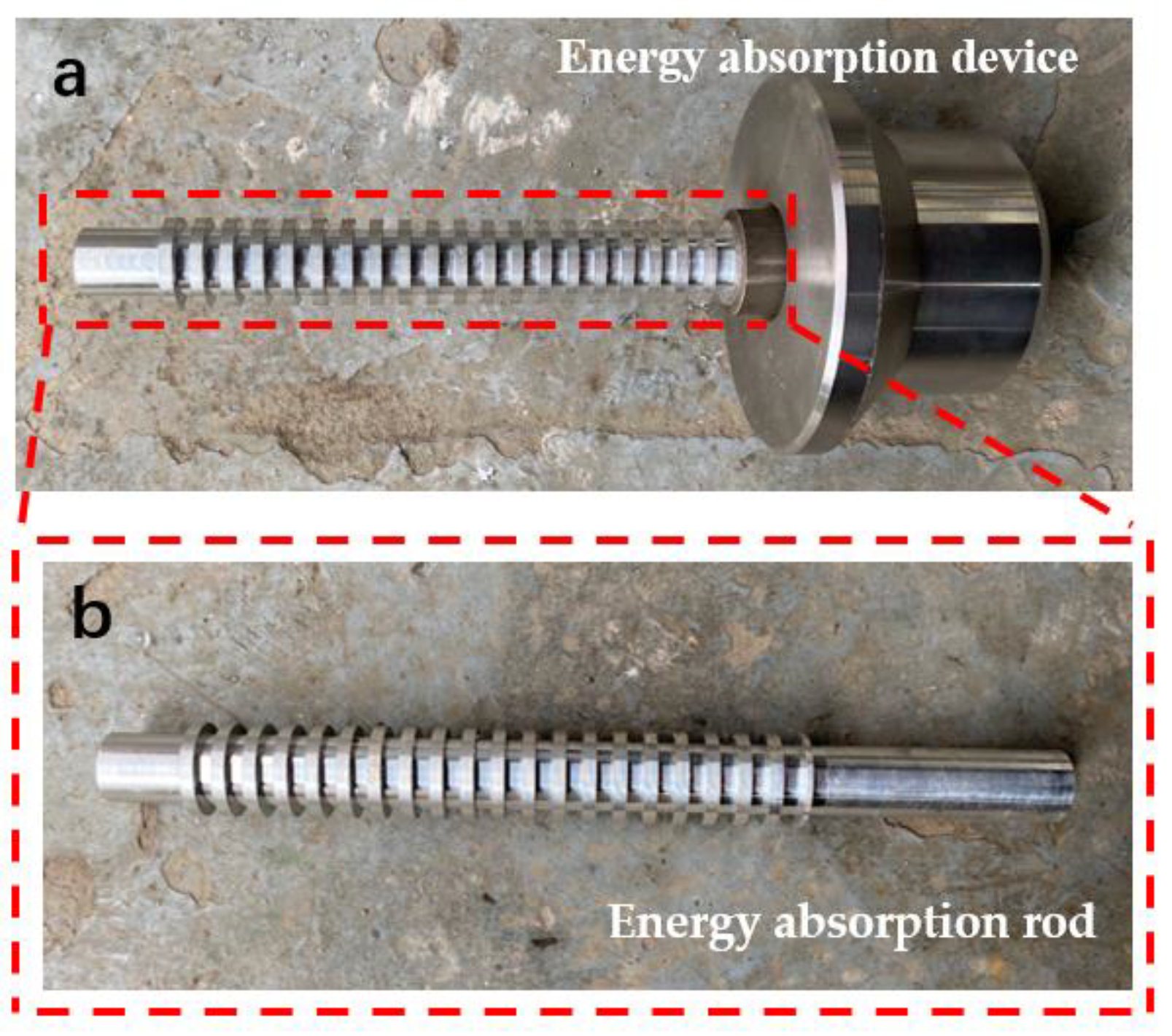

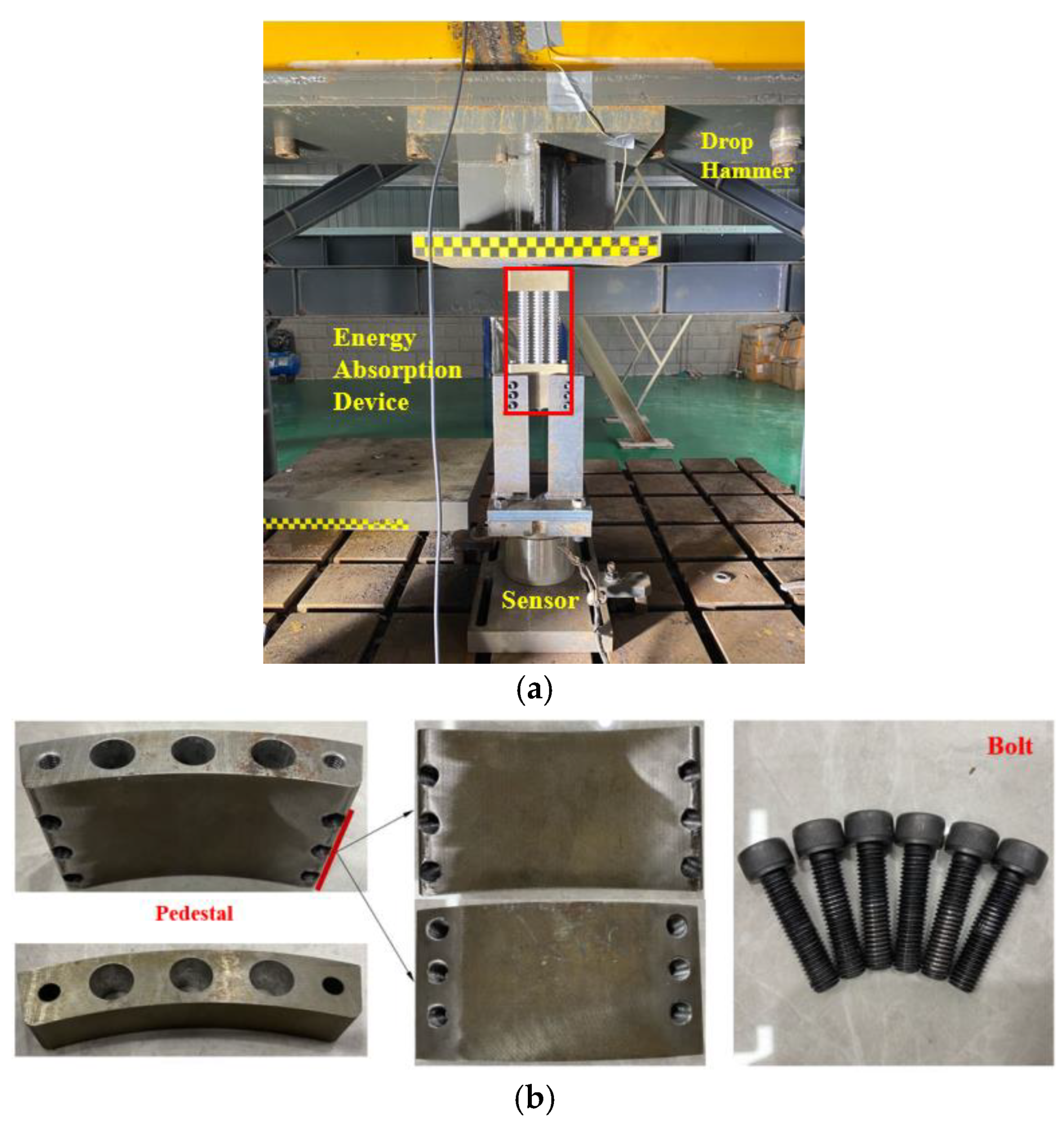

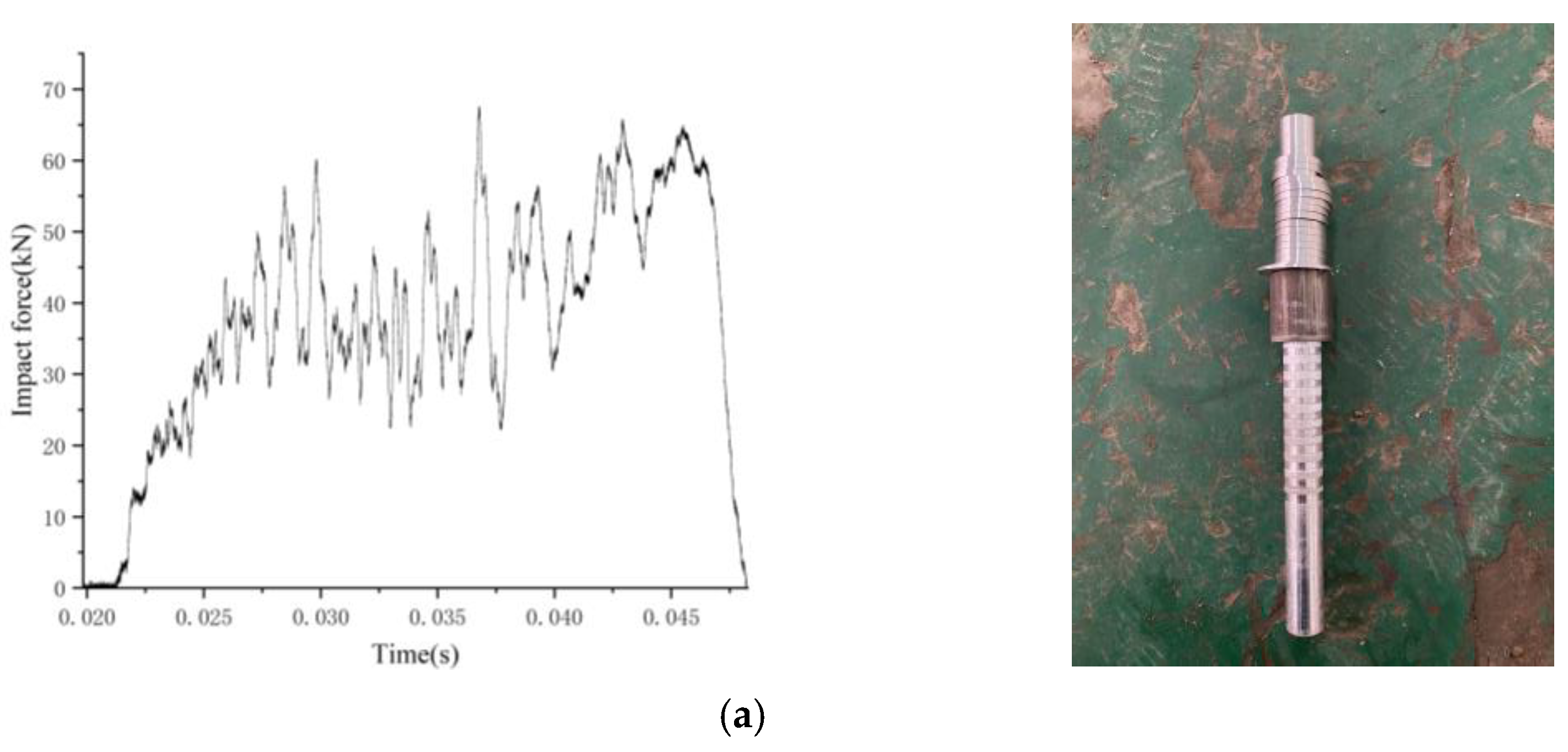
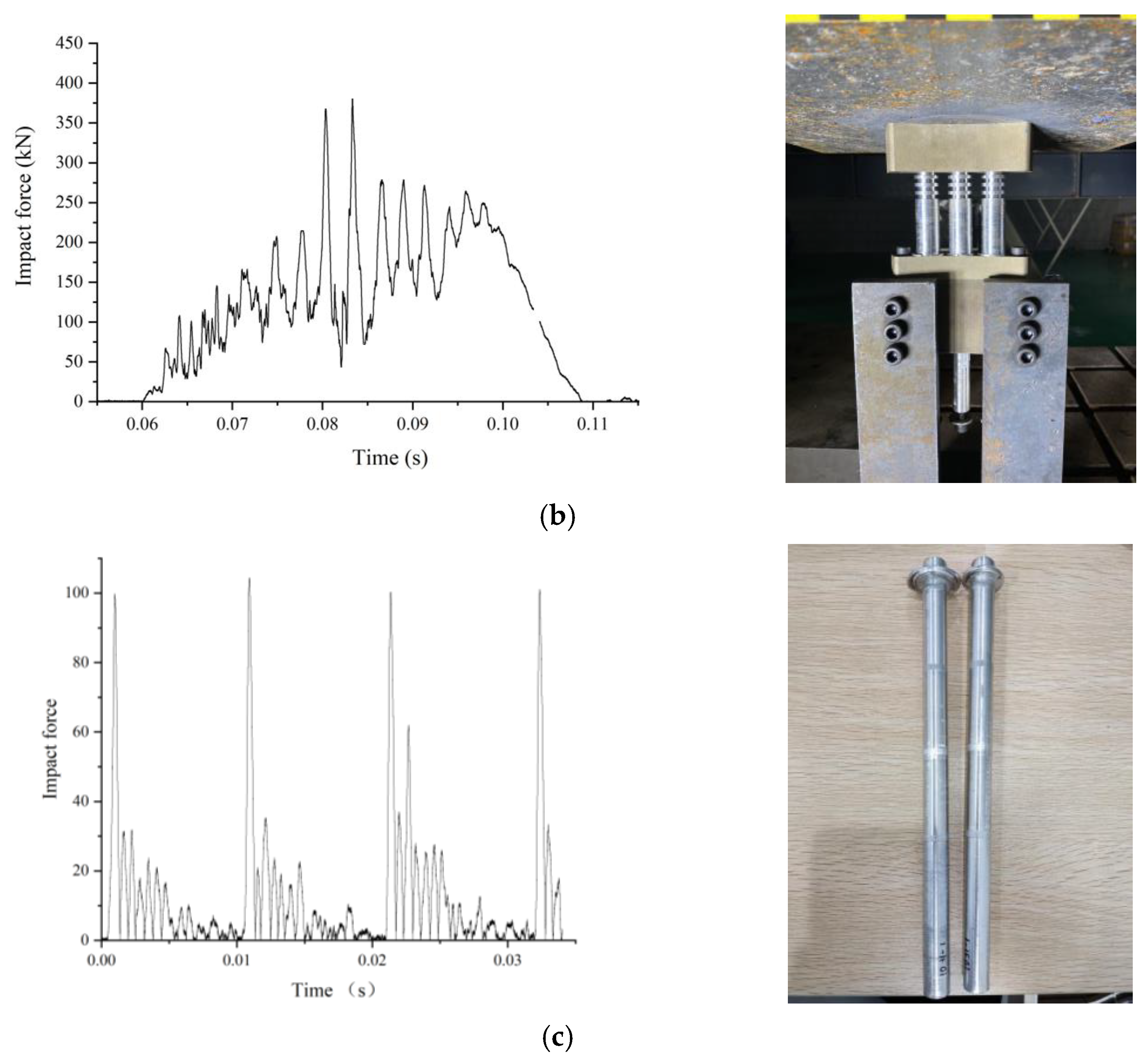
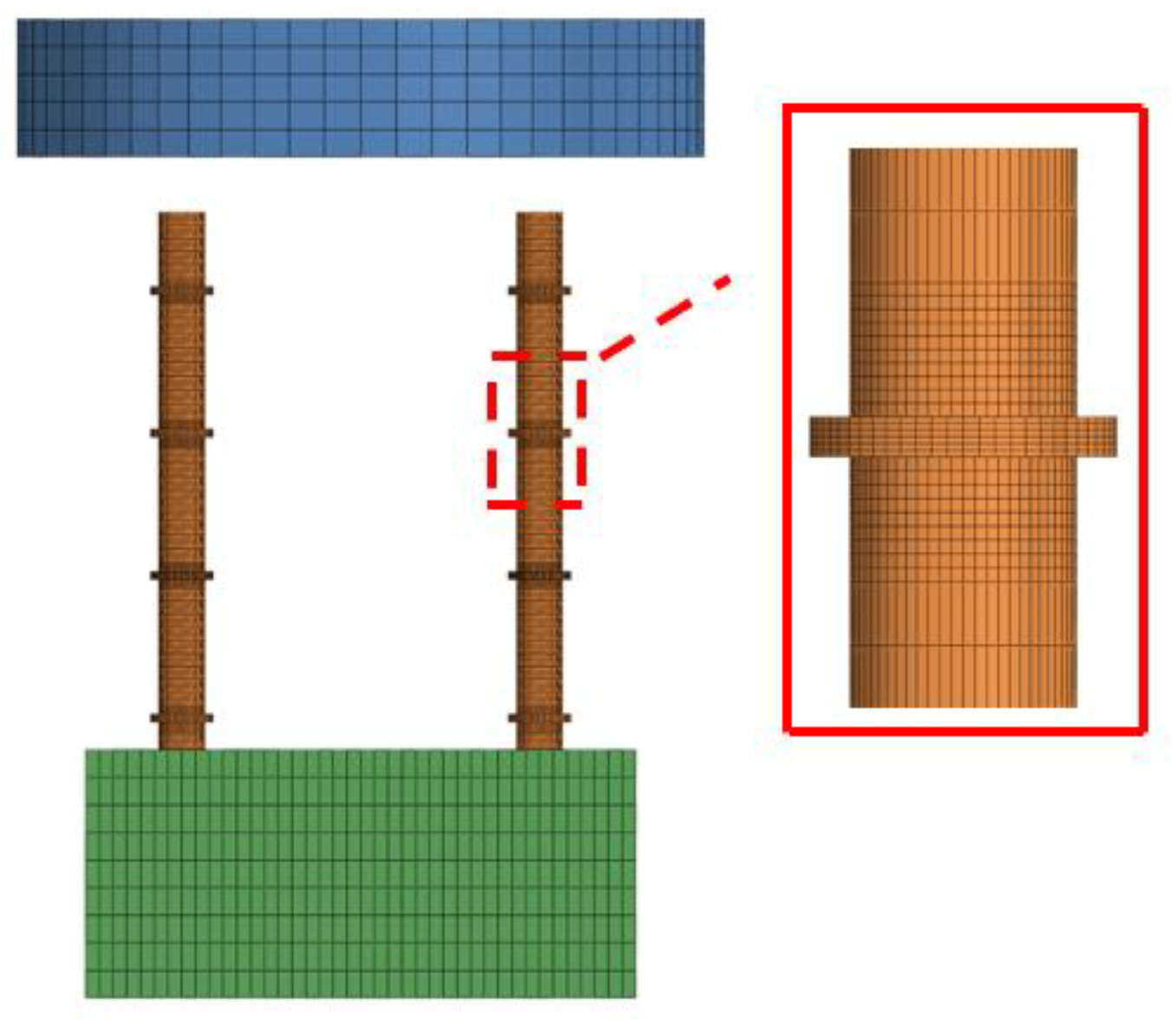
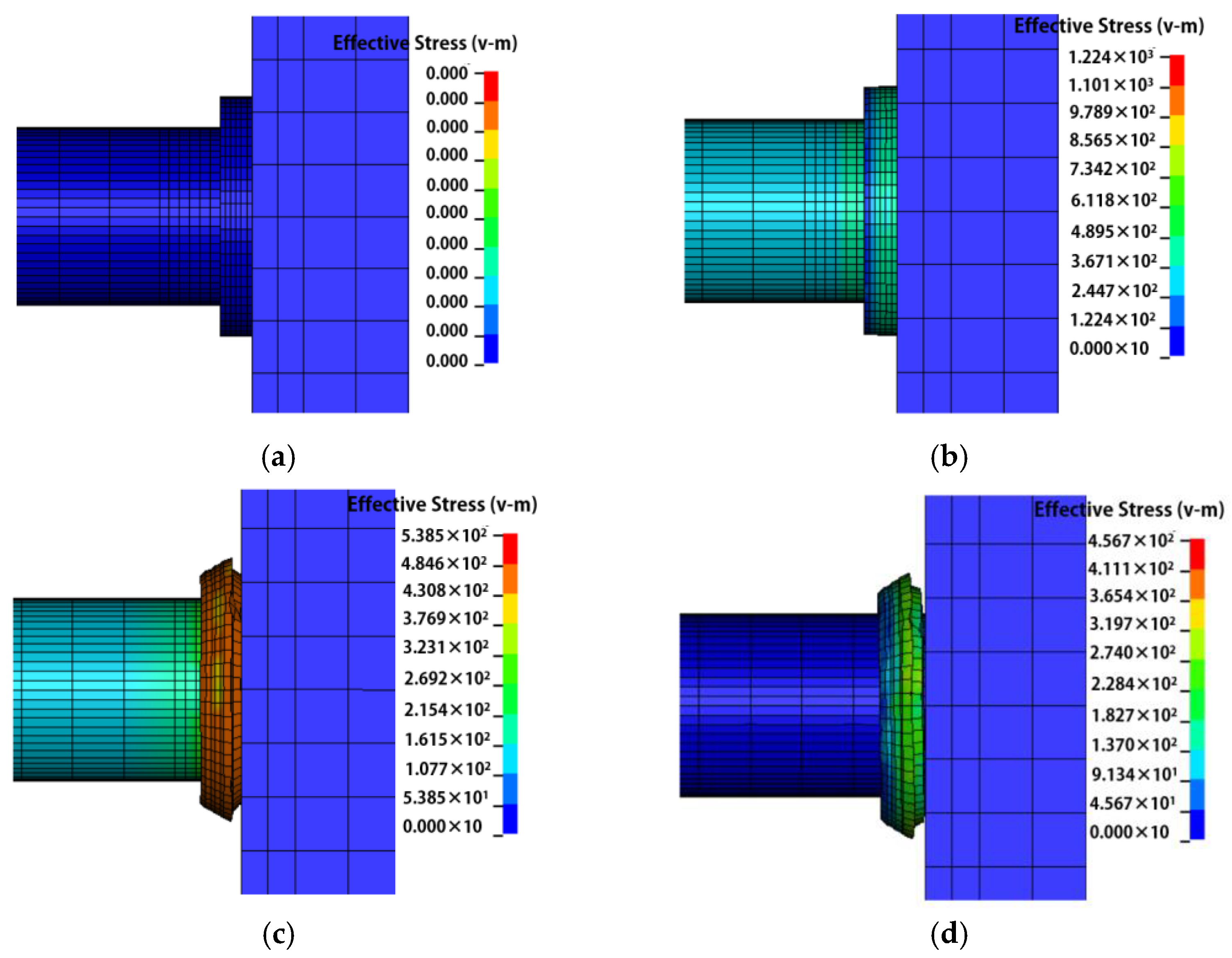
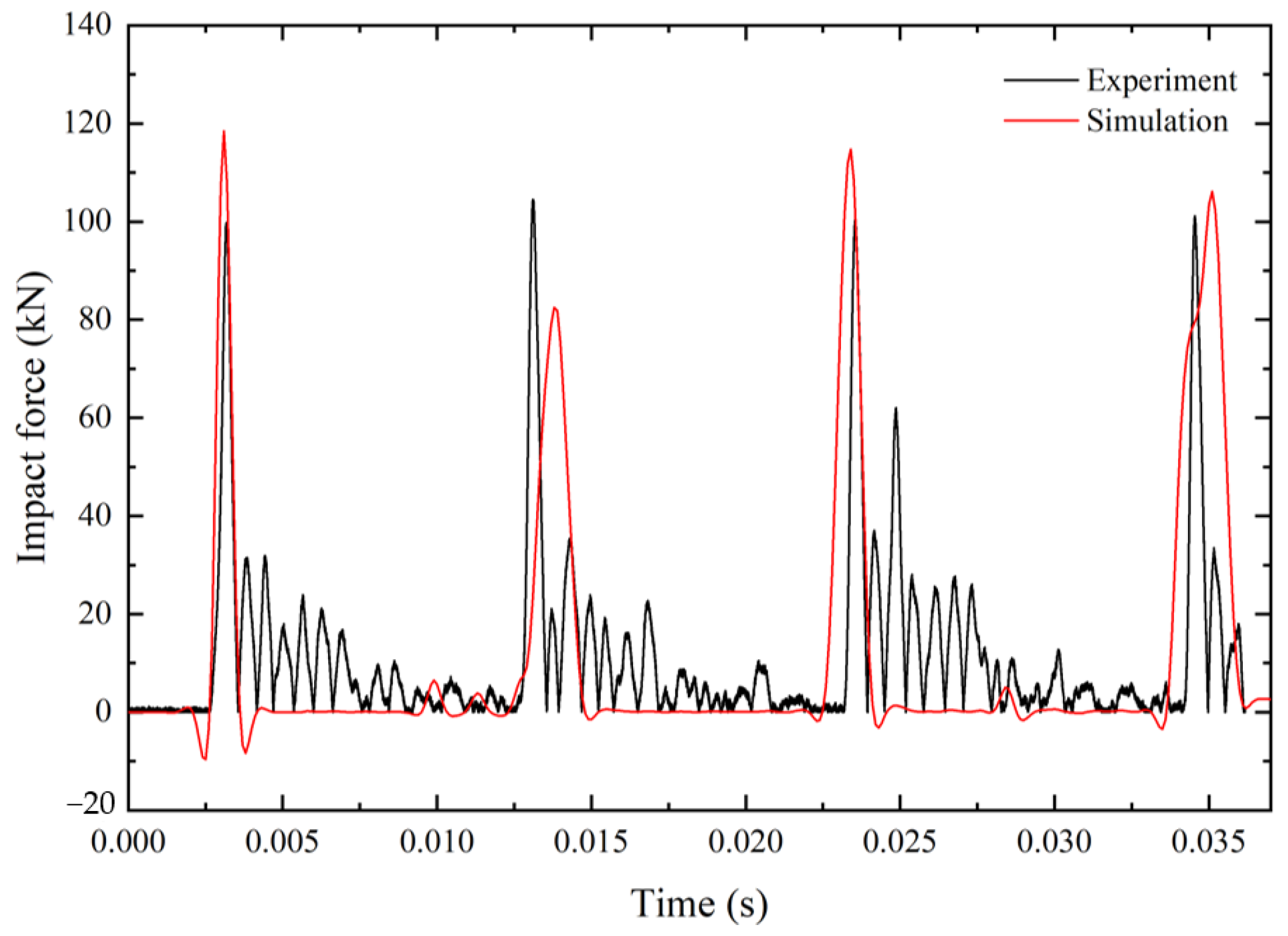

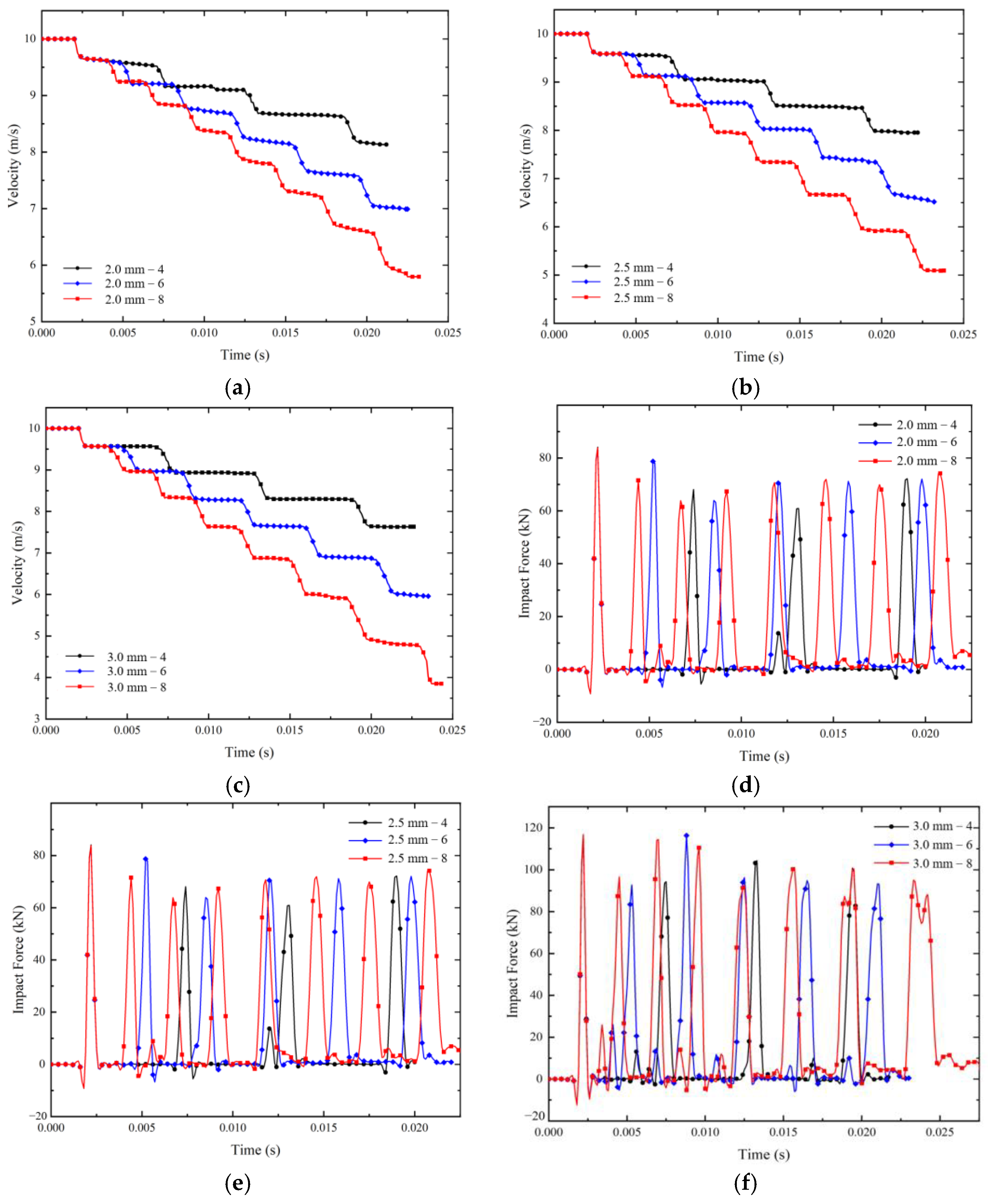
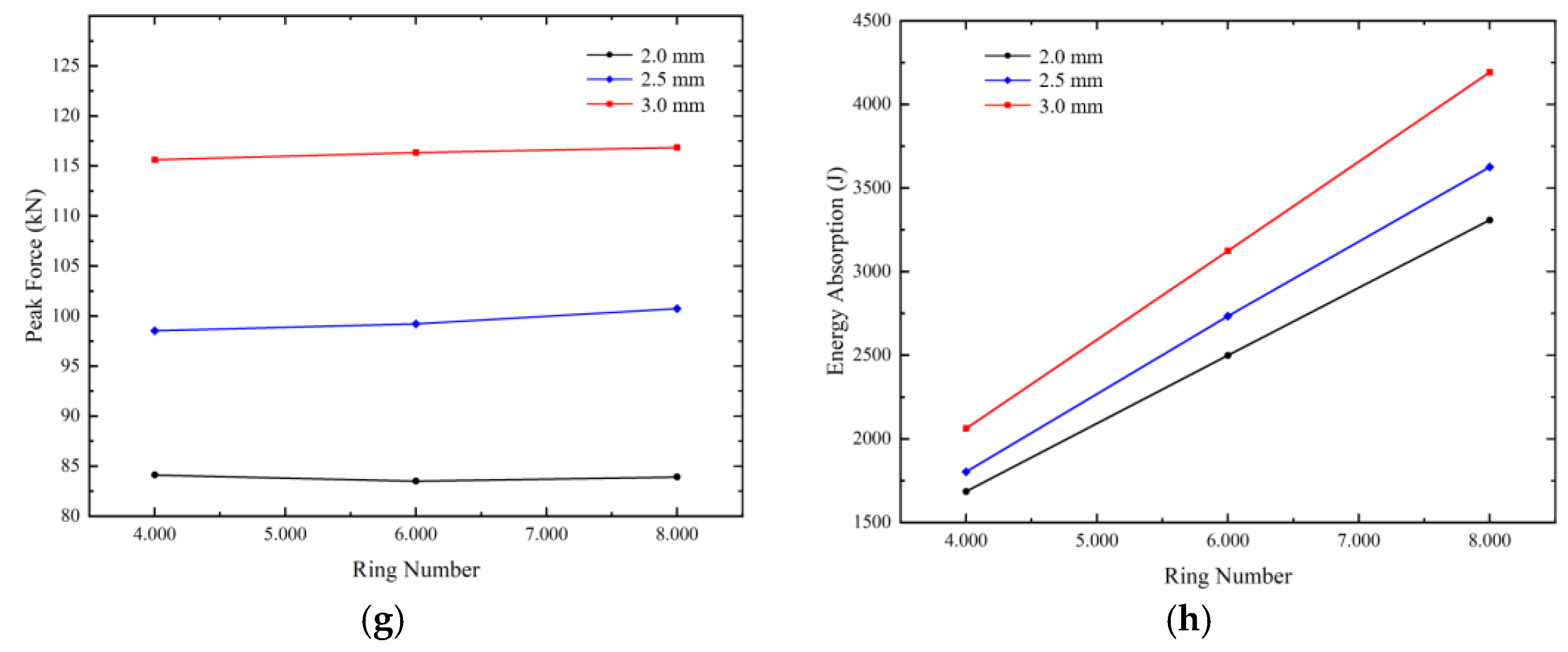
| Case | Mass (kg) | Height (m) | Number of Rods | Number of Shear Rings | Velocity (m/s) | Energy (J) |
|---|---|---|---|---|---|---|
| 1 | 98 | 2.46 | 1 | 21 | 6.94 | 2362.58 |
| 2 | 1387 | 0.60 | 3 | 21 | 3.43 | 8155.56 |
| 3 | 98 | 1.56 | 2 | 4 | 5.53 | 1402.42 |
| Al. | Zn | Mg | Cu | Cr | Si | Fe | Ti | Mn |
|---|---|---|---|---|---|---|---|---|
| Bal. | 5.80 | 0.04 | 1.40 | 0.01 | 0.07 | 0.18 | 0.03 | 0.05 |
| (kg/m3) | (GPa) | (MPa) | |
|---|---|---|---|
| 2810 | 71.7 | 0.33 | 460 |
| (kg/m3) | (GPa) | |
|---|---|---|
| 7850 | 200 | 0.30 |
| Case | Velocity (m/s) | Ring Thick (mm) | Spacing (mm)/Number of Shear Rings | Energy Absorption (J) | Impact Force (kN) |
|---|---|---|---|---|---|
| 1 | 10.0 | 2.0 | 51.67/4 | 1685.11 | 84.12 |
| 2 | 10.0 | 2.0 | 31.00/6 | 2499.02 | 83.50 |
| 3 | 10.0 | 2.0 | 22.14/8 | 3307.99 | 83.91 |
| 4 | 10.0 | 2.5 | 51.67/4 | 1803.08 | 98.53 |
| 5 | 10.0 | 2.5 | 31.00/6 | 2733.10 | 99.21 |
| 6 | 10.0 | 2.5 | 22.14/8 | 3625.51 | 100.74 |
| 7 | 10.0 | 3.0 | 51.67/4 | 2062.31 | 115.61 |
| 8 | 10.0 | 3.0 | 31.00/6 | 3124.22 | 116.34 |
| 9 | 10.0 | 3.0 | 22.14/8 | 4192.44 | 116.84 |
Disclaimer/Publisher’s Note: The statements, opinions and data contained in all publications are solely those of the individual author(s) and contributor(s) and not of MDPI and/or the editor(s). MDPI and/or the editor(s) disclaim responsibility for any injury to people or property resulting from any ideas, methods, instructions or products referred to in the content. |
© 2023 by the authors. Licensee MDPI, Basel, Switzerland. This article is an open access article distributed under the terms and conditions of the Creative Commons Attribution (CC BY) license (https://creativecommons.org/licenses/by/4.0/).
Share and Cite
Yao, S.; Wang, Y.; Sun, C.; Feng, X.; Zhao, N. Experimental and Numerical Studies on the Impact Energy Absorption of Cutting Shear Rings. Appl. Sci. 2023, 13, 1860. https://doi.org/10.3390/app13031860
Yao S, Wang Y, Sun C, Feng X, Zhao N. Experimental and Numerical Studies on the Impact Energy Absorption of Cutting Shear Rings. Applied Sciences. 2023; 13(3):1860. https://doi.org/10.3390/app13031860
Chicago/Turabian StyleYao, Shujian, Yanjing Wang, Chengming Sun, Xingmin Feng, and Nan Zhao. 2023. "Experimental and Numerical Studies on the Impact Energy Absorption of Cutting Shear Rings" Applied Sciences 13, no. 3: 1860. https://doi.org/10.3390/app13031860




